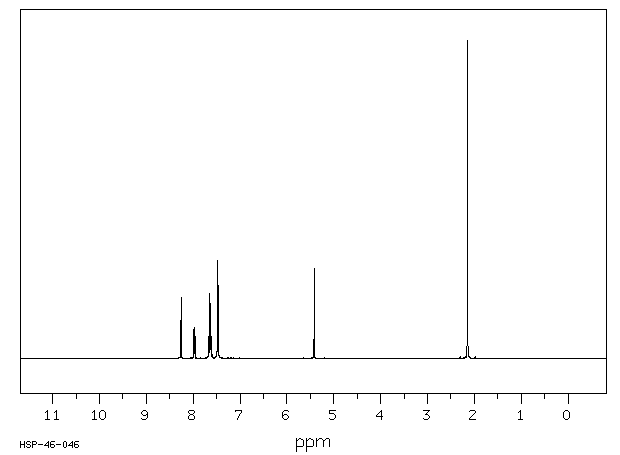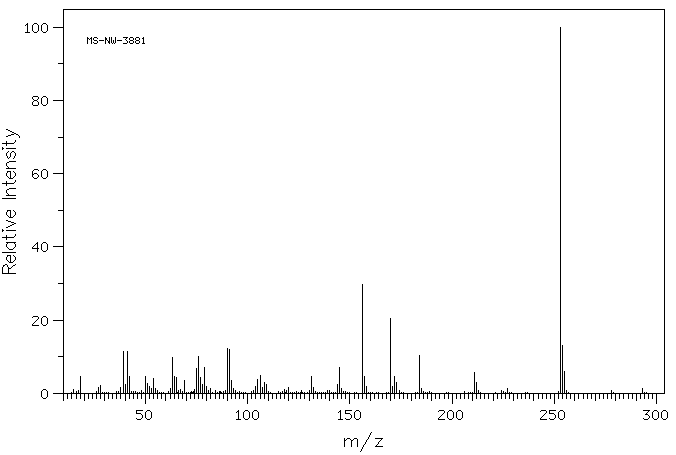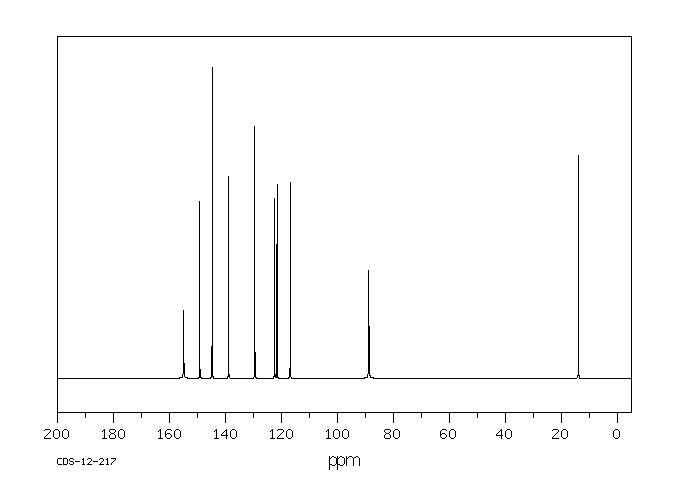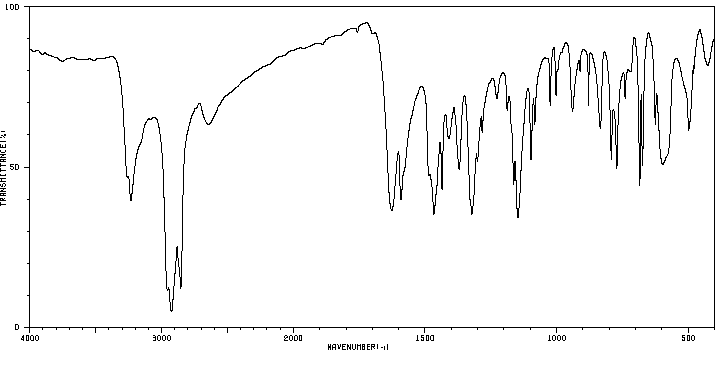3-甲基-1-(3'-磺酸氨苯基)-5-吡唑啉酮 | 89-29-2
中文名称
3-甲基-1-(3'-磺酸氨苯基)-5-吡唑啉酮
中文别名
3-(4,5-二氢-3-甲基-5-氧代-1H-吡唑-1-基)-苯磺酰胺;3-(4,5-二氢-3-甲基-5-氧代-1H-吡唑-1-基)苯磺酰胺
英文名称
1-(3-sulfoamido)-1 phenyl-3-methyl-5-pyrazolone
英文别名
1-(3-sulphoamidophenyl)-3-methyl-5-pyrazolone;3-methyl-1-(3'-sulfamoylphenyl)-5-pyrazolone;3-(4,5-dihydro-3-methyl-5-oxo-1H-pyrazol-1-yl)-benzenesulfonamide;3-(4,5-dihydro-3-methyl-5-oxo-1H-pyrazol-1-yl)-benzolsulfonamide;3-(3-Methyl-5-oxo-4,5-dihydro-1H-pyrazol-1-yl)benzenesulfonamide;3-(3-methyl-5-oxo-4H-pyrazol-1-yl)benzenesulfonamide
CAS
89-29-2
化学式
C10H11N3O3S
mdl
——
分子量
253.282
InChiKey
ASVVGQURNHNITH-UHFFFAOYSA-N
BEILSTEIN
——
EINECS
——
-
物化性质
-
计算性质
-
ADMET
-
安全信息
-
SDS
-
制备方法与用途
-
上下游信息
-
文献信息
-
表征谱图
-
同类化合物
-
相关功能分类
-
相关结构分类
物化性质
-
熔点:202-206 °C(lit.)
-
沸点:541.6±52.0 °C(Predicted)
-
密度:1.52±0.1 g/cm3(Predicted)
计算性质
-
辛醇/水分配系数(LogP):-0.2
-
重原子数:17
-
可旋转键数:2
-
环数:2.0
-
sp3杂化的碳原子比例:0.2
-
拓扑面积:101
-
氢给体数:1
-
氢受体数:5
安全信息
-
危险等级:IRRITANT
-
危险品标志:Xi
-
危险类别码:R36/37/38
-
WGK Germany:1
-
海关编码:2935009090
-
安全说明:S26,S36
-
储存条件:室温且干燥环境中保存。
SDS
3-甲基-1-(3'-磺酸氨苯基)-5-吡唑啉酮
模块 1. 化学品
产品名称: 3-Methyl-1-(3'-sulfoamidophenyl)-5-pyrazolone
模块 2. 危险性概述
GHS分类
物理性危害 未分类
健康危害
皮肤腐蚀/刺激 第2级
严重损伤/刺激眼睛 2A类
环境危害 未分类
GHS标签元素
图标或危害标志
信号词 警告
危险描述 造成皮肤刺激
造成严重眼刺激
防范说明
[预防] 处理后要彻底清洗双手。
穿戴防护手套/护目镜/防护面具。
[急救措施] 眼睛接触:用水小心清洗几分钟。如果方便,易操作,摘除隐形眼镜。继续冲洗。
眼睛接触:求医/就诊
皮肤接触:用大量肥皂和水轻轻洗。
若皮肤刺激:求医/就诊。
脱掉被污染的衣物,清洗后方可重新使用。
模块 3. 成分/组成信息
单一物质/混和物 单一物质
化学名(中文名): 3-甲基-1-(3'-磺酸氨苯基)-5-吡唑啉酮
百分比: >95.0%(T)
CAS编码: 89-29-2
分子式: C10H11N3O3S
3-甲基-1-(3'-磺酸氨苯基)-5-吡唑啉酮
模块 4. 急救措施
吸入: 将受害者移到新鲜空气处,保持呼吸通畅,休息。若感不适请求医/就诊。
皮肤接触: 立即去除/脱掉所有被污染的衣物。用大量肥皂和水轻轻洗。
若皮肤刺激或发生皮疹:求医/就诊。
眼睛接触: 用水小心清洗几分钟。如果方便,易操作,摘除隐形眼镜。继续清洗。
如果眼睛刺激:求医/就诊。
食入: 若感不适,求医/就诊。漱口。
紧急救助者的防护: 救援者需要穿戴个人防护用品,比如橡胶手套和气密性护目镜。
模块 5. 消防措施
合适的灭火剂: 干粉,泡沫,雾状水,二氧化碳
特殊危险性: 小心,燃烧或高温下可能分解产生毒烟。
特定方法: 从上风处灭火,根据周围环境选择合适的灭火方法。
非相关人员应该撤离至安全地方。
周围一旦着火:如果安全,移去可移动容器。
消防员的特殊防护用具: 灭火时,一定要穿戴个人防护用品。
模块 6. 泄漏应急处理
个人防护措施,防护用具, 使用个人防护用品。远离溢出物/泄露处并处在上风处。
紧急措施: 泄露区应该用安全带等圈起来,控制非相关人员进入。
环保措施: 防止进入下水道。
控制和清洗的方法和材料: 清扫收集粉尘,封入密闭容器。注意切勿分散。附着物或收集物应该立即根据合适的
法律法规处置。
模块 7. 操作处置与储存
处理
技术措施: 在通风良好处进行处理。穿戴合适的防护用具。防止粉尘扩散。处理后彻底清洗双手
和脸。
注意事项: 如果粉尘或浮质产生,使用局部排气。
操作处置注意事项: 避免接触皮肤、眼睛和衣物。
贮存
储存条件: 保持容器密闭。存放于凉爽、阴暗处。
远离不相容的材料比如氧化剂存放。
包装材料: 依据法律。
模块 8. 接触控制和个体防护
工程控制: 尽可能安装封闭体系或局部排风系统,操作人员切勿直接接触。同时安装淋浴器和洗
眼器。
个人防护用品
呼吸系统防护: 防尘面具。依据当地和政府法规。
手部防护: 防护手套。
眼睛防护: 安全防护镜。如果情况需要,佩戴面具。
皮肤和身体防护: 防护服。如果情况需要,穿戴防护靴。
模块 9. 理化特性
固体
外形(20°C):
外观: 晶体-粉末
颜色: 浅黄色-黄红色
气味: 无资料
3-甲基-1-(3'-磺酸氨苯基)-5-吡唑啉酮
模块 9. 理化特性
pH: 无数据资料
熔点:
196°C
沸点/沸程 无资料
闪点: 无资料
爆炸特性
爆炸下限: 无资料
爆炸上限: 无资料
密度: 无资料
溶解度:
[水] 无资料
[其他溶剂] 无资料
模块 10. 稳定性和反应性
化学稳定性: 一般情况下稳定。
危险反应的可能性: 未报道特殊反应性。
须避免接触的物质 氧化剂
危险的分解产物: 一氧化碳, 二氧化碳, 氮氧化物 (NOx), 硫氧化物
模块 11. 毒理学信息
急性毒性: 无资料
对皮肤腐蚀或刺激: 无资料
对眼睛严重损害或刺激: 无资料
生殖细胞变异原性: 无资料
致癌性:
IARC = 无资料
NTP = 无资料
生殖毒性: 无资料
模块 12. 生态学信息
生态毒性:
鱼类: 无资料
甲壳类: 无资料
藻类: 无资料
残留性 / 降解性: 无资料
潜在生物累积 (BCF): 无资料
土壤中移动性
log水分配系数: 无资料
土壤吸收系数 (Koc): 无资料
亨利定律 无资料
constaNT(PaM3/mol):
模块 13. 废弃处置
如果可能,回收处理。请咨询当地管理部门。建议在可燃溶剂中溶解混合,在装有后燃和洗涤装置的化学焚烧炉中
焚烧。废弃处置时请遵守国家、地区和当地的所有法规。
模块 14. 运输信息
联合国分类: 与联合国分类标准不一致
UN编号: 未列明
3-甲基-1-(3'-磺酸氨苯基)-5-吡唑啉酮
模块 15. 法规信息
《危险化学品安全管理条例》(2002年1月26日国务院发布,2011年2月16日修订): 针对危险化学品的安全使用、
生产、储存、运输、装卸等方面均作了相应的规定。
模块16 - 其他信息
N/A
模块 1. 化学品
产品名称: 3-Methyl-1-(3'-sulfoamidophenyl)-5-pyrazolone
模块 2. 危险性概述
GHS分类
物理性危害 未分类
健康危害
皮肤腐蚀/刺激 第2级
严重损伤/刺激眼睛 2A类
环境危害 未分类
GHS标签元素
图标或危害标志
信号词 警告
危险描述 造成皮肤刺激
造成严重眼刺激
防范说明
[预防] 处理后要彻底清洗双手。
穿戴防护手套/护目镜/防护面具。
[急救措施] 眼睛接触:用水小心清洗几分钟。如果方便,易操作,摘除隐形眼镜。继续冲洗。
眼睛接触:求医/就诊
皮肤接触:用大量肥皂和水轻轻洗。
若皮肤刺激:求医/就诊。
脱掉被污染的衣物,清洗后方可重新使用。
模块 3. 成分/组成信息
单一物质/混和物 单一物质
化学名(中文名): 3-甲基-1-(3'-磺酸氨苯基)-5-吡唑啉酮
百分比: >95.0%(T)
CAS编码: 89-29-2
分子式: C10H11N3O3S
3-甲基-1-(3'-磺酸氨苯基)-5-吡唑啉酮
模块 4. 急救措施
吸入: 将受害者移到新鲜空气处,保持呼吸通畅,休息。若感不适请求医/就诊。
皮肤接触: 立即去除/脱掉所有被污染的衣物。用大量肥皂和水轻轻洗。
若皮肤刺激或发生皮疹:求医/就诊。
眼睛接触: 用水小心清洗几分钟。如果方便,易操作,摘除隐形眼镜。继续清洗。
如果眼睛刺激:求医/就诊。
食入: 若感不适,求医/就诊。漱口。
紧急救助者的防护: 救援者需要穿戴个人防护用品,比如橡胶手套和气密性护目镜。
模块 5. 消防措施
合适的灭火剂: 干粉,泡沫,雾状水,二氧化碳
特殊危险性: 小心,燃烧或高温下可能分解产生毒烟。
特定方法: 从上风处灭火,根据周围环境选择合适的灭火方法。
非相关人员应该撤离至安全地方。
周围一旦着火:如果安全,移去可移动容器。
消防员的特殊防护用具: 灭火时,一定要穿戴个人防护用品。
模块 6. 泄漏应急处理
个人防护措施,防护用具, 使用个人防护用品。远离溢出物/泄露处并处在上风处。
紧急措施: 泄露区应该用安全带等圈起来,控制非相关人员进入。
环保措施: 防止进入下水道。
控制和清洗的方法和材料: 清扫收集粉尘,封入密闭容器。注意切勿分散。附着物或收集物应该立即根据合适的
法律法规处置。
模块 7. 操作处置与储存
处理
技术措施: 在通风良好处进行处理。穿戴合适的防护用具。防止粉尘扩散。处理后彻底清洗双手
和脸。
注意事项: 如果粉尘或浮质产生,使用局部排气。
操作处置注意事项: 避免接触皮肤、眼睛和衣物。
贮存
储存条件: 保持容器密闭。存放于凉爽、阴暗处。
远离不相容的材料比如氧化剂存放。
包装材料: 依据法律。
模块 8. 接触控制和个体防护
工程控制: 尽可能安装封闭体系或局部排风系统,操作人员切勿直接接触。同时安装淋浴器和洗
眼器。
个人防护用品
呼吸系统防护: 防尘面具。依据当地和政府法规。
手部防护: 防护手套。
眼睛防护: 安全防护镜。如果情况需要,佩戴面具。
皮肤和身体防护: 防护服。如果情况需要,穿戴防护靴。
模块 9. 理化特性
固体
外形(20°C):
外观: 晶体-粉末
颜色: 浅黄色-黄红色
气味: 无资料
3-甲基-1-(3'-磺酸氨苯基)-5-吡唑啉酮
模块 9. 理化特性
pH: 无数据资料
熔点:
196°C
沸点/沸程 无资料
闪点: 无资料
爆炸特性
爆炸下限: 无资料
爆炸上限: 无资料
密度: 无资料
溶解度:
[水] 无资料
[其他溶剂] 无资料
模块 10. 稳定性和反应性
化学稳定性: 一般情况下稳定。
危险反应的可能性: 未报道特殊反应性。
须避免接触的物质 氧化剂
危险的分解产物: 一氧化碳, 二氧化碳, 氮氧化物 (NOx), 硫氧化物
模块 11. 毒理学信息
急性毒性: 无资料
对皮肤腐蚀或刺激: 无资料
对眼睛严重损害或刺激: 无资料
生殖细胞变异原性: 无资料
致癌性:
IARC = 无资料
NTP = 无资料
生殖毒性: 无资料
模块 12. 生态学信息
生态毒性:
鱼类: 无资料
甲壳类: 无资料
藻类: 无资料
残留性 / 降解性: 无资料
潜在生物累积 (BCF): 无资料
土壤中移动性
log水分配系数: 无资料
土壤吸收系数 (Koc): 无资料
亨利定律 无资料
constaNT(PaM3/mol):
模块 13. 废弃处置
如果可能,回收处理。请咨询当地管理部门。建议在可燃溶剂中溶解混合,在装有后燃和洗涤装置的化学焚烧炉中
焚烧。废弃处置时请遵守国家、地区和当地的所有法规。
模块 14. 运输信息
联合国分类: 与联合国分类标准不一致
UN编号: 未列明
3-甲基-1-(3'-磺酸氨苯基)-5-吡唑啉酮
模块 15. 法规信息
《危险化学品安全管理条例》(2002年1月26日国务院发布,2011年2月16日修订): 针对危险化学品的安全使用、
生产、储存、运输、装卸等方面均作了相应的规定。
模块16 - 其他信息
N/A
上下游信息
-
下游产品
中文名称 英文名称 CAS号 化学式 分子量 —— 3-(4-(2-ethylanilinomethylenaminomethylene)-4,5-dihydro-3-methyl-5-oxo-1H-pyrazol-1-yl)-benzolsulfonamide 184707-71-9 C20H21N5O3S 411.484
反应信息
-
作为反应物:描述:3-甲基-1-(3'-磺酸氨苯基)-5-吡唑啉酮 在 dipotassium peroxodisulfate 、 copper diacetate 作用下, 以 甲醇 、 水 、 甲苯 、 乙腈 为溶剂, 反应 17.0h, 生成 3-(4-benzoyl-2-ethyl-3-methyl-5-oxo-2,5-dihydro-1H-pyrazol-1-yl)benzenesulfonamide参考文献:名称:吡唑啉酮与α-氧代羧酸的铜/过硫酸盐促进的氧化脱羧CH乙酰化:在温和条件下可直接获得4-酰基吡唑啉酮摘要:使用α-氧代羧酸作为酰基源,开发了一种简便,有效的N-取代吡唑啉酮的氧化CH-H酰化方法。Cu(OAc)2和K 2 S 2 O 8的组合可使反应在空气中顺利进行,并以中等到极好的收率提供各种各样的4-酰基吡唑啉酮产品。据信这种转变的机理是通过铜诱导的脱羧反应形成酰基铜物质而进行的。该方法为将酰基部分直接安装到生物活性吡唑啉酮衍生物中提供了方便且有用的途径,该途径可进一步用于许多应用中。DOI:10.1002/adsc.201800464
-
作为产物:描述:参考文献:名称:吡唑啉酮与α-氧代羧酸的铜/过硫酸盐促进的氧化脱羧CH乙酰化:在温和条件下可直接获得4-酰基吡唑啉酮摘要:使用α-氧代羧酸作为酰基源,开发了一种简便,有效的N-取代吡唑啉酮的氧化CH-H酰化方法。Cu(OAc)2和K 2 S 2 O 8的组合可使反应在空气中顺利进行,并以中等到极好的收率提供各种各样的4-酰基吡唑啉酮产品。据信这种转变的机理是通过铜诱导的脱羧反应形成酰基铜物质而进行的。该方法为将酰基部分直接安装到生物活性吡唑啉酮衍生物中提供了方便且有用的途径,该途径可进一步用于许多应用中。DOI:10.1002/adsc.201800464
文献信息
-
Ligating behaviour of Schiff base ligands derived from heterocyclic β-diketone and ethanol or propanol amine with oxovanadium (IV) metal ion作者:B.T. Thaker、R.S. BarvaliaDOI:10.1016/j.saa.2009.08.041日期:2009.12aqueous ethanol medium. The ligands and their Schiff base ligands have been characterized by elemental analyses, IR and (1)H NMR. The resulting complexes have been characterized by elemental analyses, IR, (1)H NMR, mass, electronic, electron spin resonance spectra, magnetic susceptibility measurement, molar conductance and thermal studies. The IR spectral data suggest that the ligand behaves as a dibasic合成和评估由五水合硫酸氧钒与席夫碱相互作用形成的六种新的氧钒(IV)配合物。(HL(1))-(HL(3))和(HL(4))-(HL(6)),例如5-羟基-3-甲基-1(2-氯)苯基-1H-吡唑啉酮-4 -甲醛(I),5-羟基-3-甲基-1(3-氯)苯基-1H-吡唑啉酮-4-甲醛(II)和5-羟基-3-甲基-1(3-磺酰胺基)苯基-1H -吡唑酮-4-甲醛(III)在乙醇水溶液中分别与乙醇胺和丙醇胺混合。配体及其席夫碱配体已通过元素分析,IR和(1)H NMR进行了表征。所得络合物已通过元素分析,IR,(1)H NMR,质量,电子,电子自旋共振谱,磁化率测量,摩尔电导和热研究进行了表征。红外光谱数据表明,该配体表现为二元二齿,对金属离子具有ON供体序列。摩尔电导率数据显示它们为非电解质。从电子,磁性和ESR光谱数据表明,所有的氧钒(IV)配合物都具有扭曲的八面体几何形状。
-
New Furopyridines Containing Pyridoxal and Pyrazolone Fragments作者:L. K. Kibardina、A. V. Trifonov、A. R. Burilov、M. A. PudovikDOI:10.1134/s1070363218090098日期:2018.9Reactions of pyridoxal hydrochloride with 5-pyrazolone derivatives in alcohol medium in the presence of concentrated hydrochloric acid led to the formation of new pyrazolones with pyridoxal fragments in the molecule. The corresponding diarylmethanes were formed when using pyridoxal and pyrazolone in a 1: 2 ratio.
-
Method for inhibiting neoplastic lesions by administering
-
アゾ化合物申请人:日本化薬株式会社公开号:JP2016166337A公开(公告)日:2016-09-15【課題】溶解性に優れたアゾ化合物並びにその油性又は水性染料組成物を提供。【解決手段】下記式(1)で表されるアゾ化合物(R1及びR2はH、ハロゲン原子、ニトロ基、アリール基、スルホンアミド基、カルボキシル基又はC1〜4のアルキル基等;R3はH、アミノ基又はC1〜4のアルキル基等;R4及びR5はH、ハロゲン原子、ニトロ基、アリール基、C1〜4のアルキル基又はスルホンアミド基等;MはCr又はCo;R6はC6〜28のアルキル基;R7及びR8はH又は−R14−OH;R14は、C1〜15のアルキレン基)【選択図】なし
-
Microwave assisted synthesis and characterization of unsymmetrical tetradentate Schiff base complexes of VO(IV) and MoO(V)作者:B.T. Thaker、R.S. BarvaliaDOI:10.1016/j.saa.2011.08.055日期:2011.12amount and reaction time. The attempt was made to synthesize the unsymmetrical tetradentate N(2)O(2) ligands and their VO(IV) and MoO(V) unsymmetrical tetradentate Schiff base complexes by classical and microwave techniques using domestic microwave oven. The resulting unsymmetrical Schiff base ligands L(1)-L(3) characterized by different spectral methods. Their complexes with oxocations of VO(IV) and MoO(V)
表征谱图
-
氢谱1HNMR
-
质谱MS
-
碳谱13CNMR
-
红外IR
-
拉曼Raman
-
峰位数据
-
峰位匹配
-
表征信息
同类化合物
(βS)-β-氨基-4-(4-羟基苯氧基)-3,5-二碘苯甲丙醇
(S,S)-邻甲苯基-DIPAMP
(S)-(-)-7'-〔4(S)-(苄基)恶唑-2-基]-7-二(3,5-二-叔丁基苯基)膦基-2,2',3,3'-四氢-1,1-螺二氢茚
(S)-盐酸沙丁胺醇
(S)-3-(叔丁基)-4-(2,6-二甲氧基苯基)-2,3-二氢苯并[d][1,3]氧磷杂环戊二烯
(S)-2,2'-双[双(3,5-三氟甲基苯基)膦基]-4,4',6,6'-四甲氧基联苯
(S)-1-[3,5-双(三氟甲基)苯基]-3-[1-(二甲基氨基)-3-甲基丁烷-2-基]硫脲
(R)富马酸托特罗定
(R)-(-)-盐酸尼古地平
(R)-(-)-4,12-双(二苯基膦基)[2.2]对环芳烷(1,5环辛二烯)铑(I)四氟硼酸盐
(R)-(+)-7-双(3,5-二叔丁基苯基)膦基7''-[((6-甲基吡啶-2-基甲基)氨基]-2,2'',3,3''-四氢-1,1''-螺双茚满
(R)-(+)-7-双(3,5-二叔丁基苯基)膦基7''-[(4-叔丁基吡啶-2-基甲基)氨基]-2,2'',3,3''-四氢-1,1''-螺双茚满
(R)-(+)-7-双(3,5-二叔丁基苯基)膦基7''-[(3-甲基吡啶-2-基甲基)氨基]-2,2'',3,3''-四氢-1,1''-螺双茚满
(R)-(+)-4,7-双(3,5-二-叔丁基苯基)膦基-7“-[(吡啶-2-基甲基)氨基]-2,2”,3,3'-四氢1,1'-螺二茚满
(R)-3-(叔丁基)-4-(2,6-二苯氧基苯基)-2,3-二氢苯并[d][1,3]氧杂磷杂环戊烯
(R)-2-[((二苯基膦基)甲基]吡咯烷
(R)-1-[3,5-双(三氟甲基)苯基]-3-[1-(二甲基氨基)-3-甲基丁烷-2-基]硫脲
(N-(4-甲氧基苯基)-N-甲基-3-(1-哌啶基)丙-2-烯酰胺)
(5-溴-2-羟基苯基)-4-氯苯甲酮
(5-溴-2-氯苯基)(4-羟基苯基)甲酮
(5-氧代-3-苯基-2,5-二氢-1,2,3,4-oxatriazol-3-鎓)
(4S,5R)-4-甲基-5-苯基-1,2,3-氧代噻唑烷-2,2-二氧化物-3-羧酸叔丁酯
(4S,4''S)-2,2''-亚环戊基双[4,5-二氢-4-(苯甲基)恶唑]
(4-溴苯基)-[2-氟-4-[6-[甲基(丙-2-烯基)氨基]己氧基]苯基]甲酮
(4-丁氧基苯甲基)三苯基溴化磷
(3aR,8aR)-(-)-4,4,8,8-四(3,5-二甲基苯基)四氢-2,2-二甲基-6-苯基-1,3-二氧戊环[4,5-e]二恶唑磷
(3aR,6aS)-5-氧代六氢环戊基[c]吡咯-2(1H)-羧酸酯
(2Z)-3-[[(4-氯苯基)氨基]-2-氰基丙烯酸乙酯
(2S,3S,5S)-5-(叔丁氧基甲酰氨基)-2-(N-5-噻唑基-甲氧羰基)氨基-1,6-二苯基-3-羟基己烷
(2S,2''S,3S,3''S)-3,3''-二叔丁基-4,4''-双(2,6-二甲氧基苯基)-2,2'',3,3''-四氢-2,2''-联苯并[d][1,3]氧杂磷杂戊环
(2S)-(-)-2-{[[[[3,5-双(氟代甲基)苯基]氨基]硫代甲基]氨基}-N-(二苯基甲基)-N,3,3-三甲基丁酰胺
(2S)-2-[[[[[((1S,2S)-2-氨基环己基]氨基]硫代甲基]氨基]-N-(二苯甲基)-N,3,3-三甲基丁酰胺
(2S)-2-[[[[[[((1R,2R)-2-氨基环己基]氨基]硫代甲基]氨基]-N-(二苯甲基)-N,3,3-三甲基丁酰胺
(2-硝基苯基)磷酸三酰胺
(2,6-二氯苯基)乙酰氯
(2,3-二甲氧基-5-甲基苯基)硼酸
(1S,2S,3S,5S)-5-叠氮基-3-(苯基甲氧基)-2-[(苯基甲氧基)甲基]环戊醇
(1S,2S,3R,5R)-2-(苄氧基)甲基-6-氧杂双环[3.1.0]己-3-醇
(1-(4-氟苯基)环丙基)甲胺盐酸盐
(1-(3-溴苯基)环丁基)甲胺盐酸盐
(1-(2-氯苯基)环丁基)甲胺盐酸盐
(1-(2-氟苯基)环丙基)甲胺盐酸盐
(1-(2,6-二氟苯基)环丙基)甲胺盐酸盐
(-)-去甲基西布曲明
龙蒿油
龙胆酸钠
龙胆酸叔丁酯
龙胆酸
龙胆紫-d6
龙胆紫










